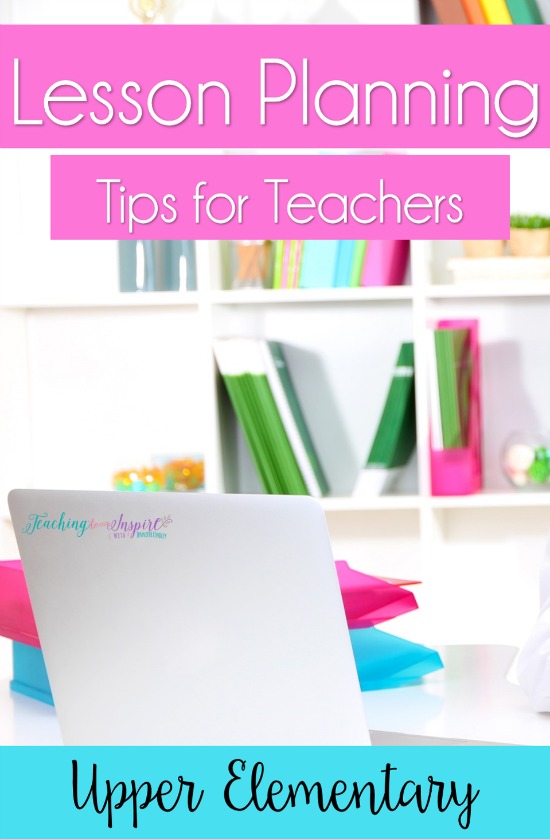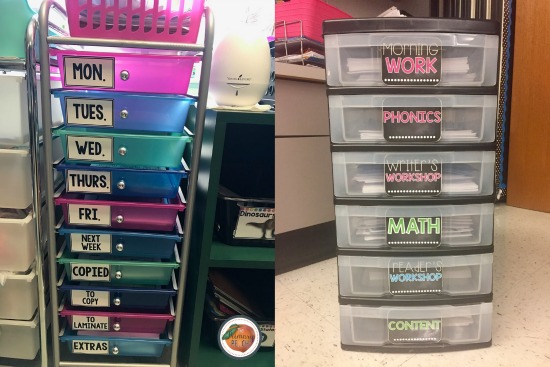Lesson planning can be a serious cause for frustration for teachers, both new and experienced. You want to have good lesson plans to both guide your instruction and meet the needs of your school requirements, but you don’t won’t to spend all of your time planning for your lessons with little time to prepare the actual lessons. Or worse, you don’t want to spend your weekends and evening planning and prepping.
In this post, I want to give you some lesson plan tips and ideas for how you can streamline your planning routine by looking at what I do and what has worked for me for the past 9+ years.

Use a pacing guide to guide your weekly plans.
Pacing guides are super important to me. I need to know the big picture, I need to know how much time I have to spend on topics, and I need to ensure I have enough time to cover all of my standards. As important as they are to me, I also keep in mind that they are just guides so they are not the end-all-be-all and you can and should tweak them to meet your students’ needs.
No matter how much you have to tweak them or how much your district requires you to stay on pace, having a pacing guide in place can greatly help you with your lesson planning each week. Most districts provide pacing guides or schools have created them.
If you teach 5th grade (and follow the common core standards or some variation of them), you can check out my pacing guides by clicking on the links below:
5th Grade Literacy Pacing Guide
If the thought of creating a year-long pacing guide is daunting (it definitely is!) start small by creating a monthly or quarterly pacing guide.
Create a lesson plan template that works for you and your school.
Over the years I have used several different lesson plan templates depending on my school and my own needs. The majority of my lesson plans were simply typed into a template I created on Powerpoint. Two years ago, I started using Planbook (school requirement), and I don’t think I will honestly go back to my powerpoint template. I love planbook because I can easily customize the template, insert common core standards quickly, and edit and add to my plans from any computer with internet access.
No matter what template you use, keep these in mind:
- Include any school requirements: differentiation, enrichment ideas, essential questions, etc.
- Include any evaluation criteria: if you are evaluated on your differentiation, make sure you include a section to plan for it.
- Include a to-do list area: this one is a recent favorite and one of those “Why did I not do this sooner?” While I am planning for each subject (more about that in a minute), I make a note of anything I need to create, copy, or find and jot it down in the to-do list section of my lesson plan template.
Start with the end in mind.
Before I even start planning, I look to where my students are headed with this skill or what the requirement are from the state. For me, this means pulling the formal assessment I plan to use first and having it readily available as I plan. This will ensure my daily plans build up to and meet the rigor of the assessment.
Schedule specific tasks for each day of the week.
Instead of randomly planning each day, I create specific guidelines for what I will plan for daily. This holds me accountability and the routine factor of it keeps me efficient and productive. Here is what I do each day on a normal week:
Monday: Quickly, look over all of my standards that I need to teach the next week to start thinking and brainstorming. Pull my daily read alouds and common texts for my reading lessons. (Click here to read more about how I teach reading and use read alouds and common texts.)
Tuesday: Using read alouds and common texts, I plan reading and writing lessons and make any necessary copies for those subjects. (Want to read more about my writing lessons? Click here.)
Wednesday: Plan math and homework for the week. Make math copies, pull math centers (read more about my typical math centers here), and copy my homework for the week. I use homework packets because it works really well for me and my students. You can read more about my homework and why I use weekly packets by clicking here.
Thursday: Plan science and social studies and make copies for those subjects.
Friday: Make any additional copies needed. Check my to-do list section of my lesson plan template and complete/check off as needed.
Batch plan subjects (vs days).
As you can see above, I don’t plan day to day for all subjects. I plan one subject from start to finish. This makes a huge difference because I am not bouncing from subject to subject. Also, I can ensure the progression of my lessons and skills is aligned with my standards.
Keep your weekly copies organized.
As you can see from the section titled Schedule specific tasks for each day of the week, all of my copies are made the week before. Since I do it this way, I need to keep them organized. I prefer to use a plastic multiple drawer container and organize my copies by subjects.
Another option is to organize by day. I have done this as well, but for me, organizing by subject works. This way if I get ahead or behind in my plans, I don’t need to move my copies around to different days. They simply stay in their subject drawer. However, find the way that works best for you and don’t be afraid to change it up!
Picture Credit: True Life I’m a Teacher and The Primary Peach
Additional Lesson Planning Tips
1.) Save plans from year to year to use as a starting point, either electronically or a hard copy. If you save a hard copy, make notes on what went well, what you would tweak, and what you would not do at all. If you plan electronically, make notes on your pacing guide.
2.) Be consistent with certain aspects of planning to save time. I keep my math centers and homework very consistent and this saves me tons of time searching for new resources (not to mention the instructional time saved because I don’t have to explain new directions and expectations all the time).
3.) Make To Do Lists directly on your plans and check off the items when you are done. I have mentioned this twice in the above sections, but I really want to bring this up again because it was that much of a game changer for me. Your next week’s self will greatly thank you for this as you will be have everything you need or you will know exactly what you still need to execute your plans.
4.) Figure out when you work best if you need additional planning time other than your prep time. When are you most productive? When do you have fewer distractions? For example, I pretty much have negative productivity after school so I don’t plan on staying late to wrap up lessons. I always come in a few minutes early when the school is still quiet and my brain is fresh.
5.) Store any extra class sets of printables that were not used in a emergency substitute tub.
6.) Choose centers that are low prep or that can be easily prepped by your students coming in early in the morning. I had a group of girls who loved coming in early and they prepped my math centers. If you are interested in reading more about my math centers, click here to take a peek into my math centers. If you would like to read more about some reading centers I have used, click here to see my favorite reading centers and grab several low prep free reading centers.
What lesson plan tips do you have that you can share with us? I am always looking for ways to streamline my lesson planning. Leave me a comment and share your tip or idea!









I was wondering about your homework packets. I love yours and do something similar now but my question is about sending it all home at once as a packet. I did that previously but found that some students would do it all on Monday and be finished. They didn’t practice the concept of working with the same text multiple days. I understand when you might need to do two nights at once due to church or sports but doing it all at once started driving me crazy. Some teachers I know don’t mind but I feel to practice getting ready for middle school, it doesn’t help to do it all on Monday and be done. Is this a situation in your room with homework and how do you handle it? Thanks so much.
Hi Alicia, yes that can be a challenge. Here is how I try to avoid that from happening:
1) We go over the homework daily so students know I will see if they do it all in one night.
2) I sometimes will randomly take off a problem from the homework the day of to encourage them to wait and do it daily, just in case I decrease the expectation or even change it.
Honestly, I don’t mind too much if they complete all of their other homework on Monday as long as they do the reading daily. Communicating that to them and explaining why they should reread daily does help.
Hope this helps!
Jennifer
Can you share the homework packet so that I can see it? Thanks for your tips and resources! I love it!
I am just starting with using Planbook. Can you share a screenshot of how yours looks with the templates you use? Do you have any tips and tricks you can share? Do you create units and lessons within the unit? Thanks in advance for any help or suggestions you can give.
What I struggle with is the expectation at my school that all grade level teachers plan together and write team lesson plans. I think I was a more effective teacher when I was permitted to find and use the resources that work best with my teaching style rather than use a one-size-fits-all lesson. I would love to know how to cope with this restriction.
Hi MaryAnn, this was the expectation at the school I taught at for my first three years teaching. Even though I was a newish teacher at the time, I still felt the same way you did. Here was what I did:
1.) I found activities and lessons beforehand and presented them to the team. Often I could sell them on trying it out.
2.) I convinced the team to partner-plan and we split off and planned the lessons for the subjects we were most passionate about.
3.) I implemented small group teaching and my teammates did not. I would use the activities we planned with whole group and then my own teaching style small group.
4.) Sometimes, I would do only parts of activities we had planned together, modify it to fit my teaching style, or skip it/replace it all together.
My school also had the expectation that we had to be on the same page, instructionally speaking. My principal wanted to be able to leave one room, enter another room, and have it be a continuation. That had an entire other layer of complication. I planned a lot beforehand and presented it to my team and that helped a lot.
I hope these tips help!
Love, love, lpve the check;ist! Thanks!
You’re welcome!
Jennifer, what teacher planner do you recommend? I’m really over the Erin Condren planners. Any others you’ve used or liked?
Hi Tiffany, I’ve never used a teacher planner so I can’t recommend one. I used planbook to plan and then a desktop calendar to keep track of meetings.
Diante disso, as meninas se divertiram bastante brincando. http://www.smbalaji.edu.in/members/mariasarahdamo/activity/2140/
Hello, this weekend is nice in favor of me, since this occasion i am reading this impressive educational post
here at my home.
Comprove isto meu fantástico weblog; como ganhar dinheiro com
comida (elektrofahrer.ch)